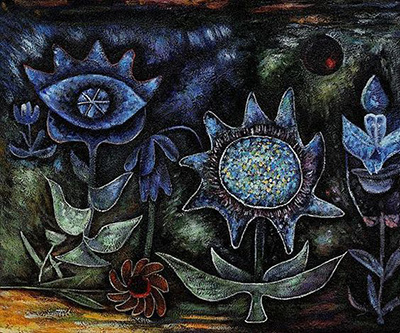Paul Klee explores the beauty of flowers again in Blossoms in the Night. Like his painting of Flowers In Stone, Klee emphasises the beauty of blooms without even having to do a photo realistic portrayal of them.
He does this by focusing on how he reacts to their colour and design.
Abstract painters sometimes shy away from portrayals of beauty in the natural world. Many may stick to concepts or ideals outside of that sphere.
However, Paul Klee regularly uses his experience with Expressionism to explore the impact soft petals have on those looking on. He unreservedly aims to bring out the feeling evoked in him by their hues and arrangement at night.
Flowers In Stone was completed using the artist's impression of flowers during the daytime. This piece is different. Everything in the painting points to a different time of the day. It may also be that since the painting was completed in 1930, the piece was also the artist's attmept to find solace in natural beauty during a difficult time politically.
The main hues used for the flowers and the background are green and blue. This lends an interesting variation in texture to the painting. The background seems at points to almost swirl around the main flowers. The flowers, background and colours all combine in a way which seems to create a place of solace. Viewers are invited in to look further at the details in the piece.
Flowers In Stone has a different role to play in society from Blossoms in the Night. While the former focuses mainly on the beauty of the flowers and is more passive, Blossoms in the Night actively invites a strong response. Klee has designed it with a level of intention that is hard to resist. It seeks to involve the viewer more in the piece.
Blossoms in the Night, like many other pieces Klee completed in later life, draws on his extensive knowledge of how colour is used to both lend comfort and inspire. The artist has several pieces that look at the impact of the time of day on regular things. By its very design, viewers are required to stop, take a look and dive into the comfort offered by the painting.




